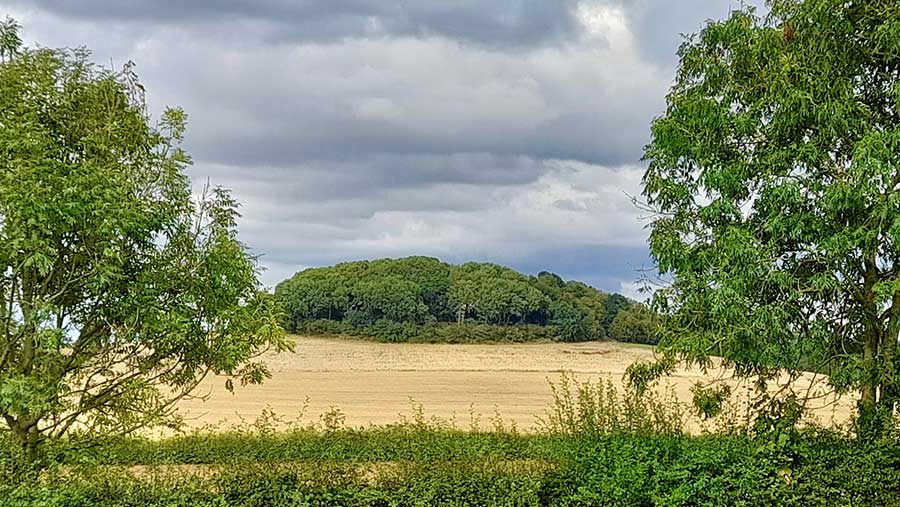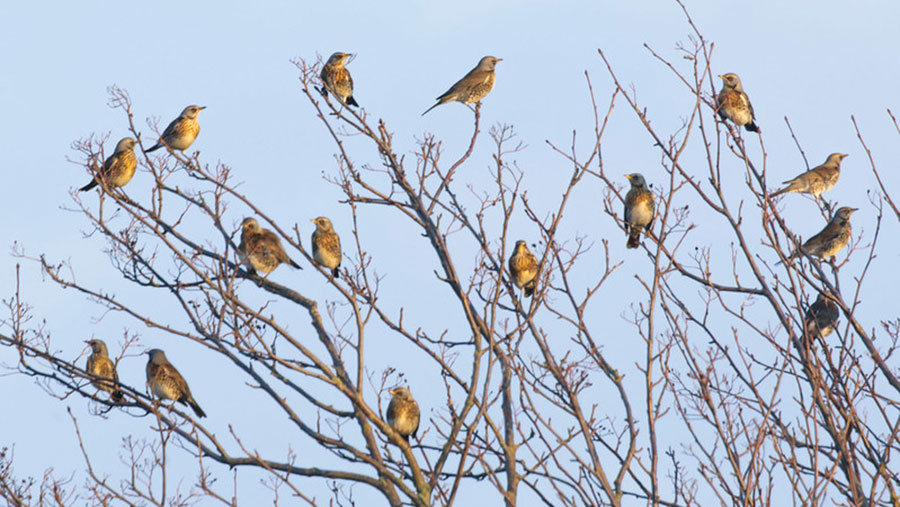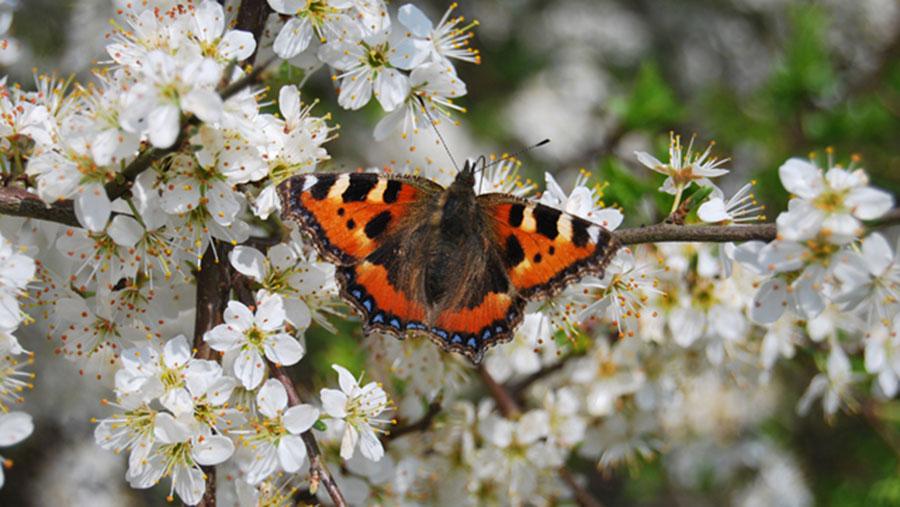Advertiser content
A practical approach to improving biodiversity and farm resilience
 Plots for resource protection placed on high sloping ground © Stuart Holm
Plots for resource protection placed on high sloping ground © Stuart Holm Biodiversity is an increasingly hot topic within the agricultural sector. Lloyds Bank caught up with Stuart Holm, farmer and outreach manager at The Woodland Trust to discuss the opportunities to improve farm resilience and the approach he takes to biodiversity on his land.
Research shows biodiversity on UK farms has fallen to around 30% of 1970 levels. Intensive farming practices including increased chemical usage, frequent cultivation and the loss of UK hedgerows, orchards and wild spaces are all contributing factors.
Farmland accounts for 71% of the UK countryside, so getting biodiversity right on this land is essential part of mitigating the climate, nature and food security crises.
So Stuart, could you talk us through the composition of your land?
Sure, I’ve got about 200 acres of land in Leicestershire, that I mainly farm through a contractor who happens to be my next-door neighbour.
We’re predominantly arable – pretty much all combinable crops – with some ridge and furrow. We also have about 40 acres of woodland including some SSSI ancient woodland, that we manage in-house.
Around a third of the fields are grass strips and margins to try to help with run-off, which is a particular challenge in the area due to heavy clay soils.
You mentioned water run-off, what kind of effect has that had on your land?
Well, a large part of the land is in grass strips and margins to accommodate the semi-regular flooding. We have a number of silt capture ponds, which are designed to help reduce soil erosion and nutrient loss.
These work by capturing the soil particles from the water before it flows off the farm. As well as some leaky dams – made with natural materials – which were built in partnership with the Allerton Trust a couple of years ago and help to slow the flow of the water courses during flash flooding. Soil degradation and erosion is a huge challenge. Along with compaction, it’s estimated to result in losses of about £1.2 billion a year and damages the productivity of UK soils for food production.
It’s not uncommon for farmers to lose thousands of tonnes of soil per year in run-off of nutrient dense soil. We’re trying through margins, grassland, and silt capture ponds to do our best to limit that.
By working to mitigate the flooding where we are in the upper catchment, it’s helped to reduce the impact in other parts of the catchment, including in the Eye Brook Reservoir nearby where too much sediment was gathering at the bottom of the reservoir, rich in nitrogen and phosphates.
How are you managing soil health, have you made any changes to be more sustainable?
Within the agriculture sector I think we all know that if you can get your soil right it has huge benefits for the overall land health and farm business, so it’s definitely something we’ve focused on.
In previous years, like many other farmers, we took it for granted that we always needed to put a certain amount of fertiliser, pesticides or herbicides on the land. But as regenerative agriculture is gaining traction, it’s really changed our approach.
We test the soil condition across the farm for nutrient levels around every four years now so that we can be sure that we’re only adding fertiliser where it’s really required for the crop.
We’ve applied the same approach with herbicides and pesticides too, which we know will have a positive impact on the land from the reduction in chemicals.
From making these changes we’ve managed to make some savings from a financial perspective as well, which has been particularly welcome given the recent volatility of fertiliser prices.
Other than that, we’re trying to take steps to a move towards sewage sludge, chicken manure and green manures. This year we planted a mixture of black oats, clovers and phacelia as overwintered cover to help improve soil condition.
We’ve only been using these for the last three or four years, so it’s early days still. There have been limited impacts on the yields so far, but it will add to the soil structure and help towards healthier soils in the future.
Do you have any examples of how you’ve seen biodiversity change on the farm?
I’ve been lucky enough to grow up on the farm, so I’ve definitely seen the impact of some of the changes that have been made. One of the biggest changes has been to the bird population.
We’ve got some areas of the farm that are heavy ground, making them much less productive. For years we’ve turned these areas over to nature, spreading wild bird seed.
It’s been really rewarding to watch the flocks grow and see new species come to the farm over the years that we’ve never seen before.
We’ve positioned this land next to the SSSI woodland so the birds have an area to shelter in, in the event of predators and this wild area can act as a much-needed buffer to protect the ancient woodland.

Bird Flock – Photo Credit: John Bridges © WTML
Because the land is under a Countryside Stewardship Scheme for resource protection, we’re also still able to collect a grant payment for the area.
It’s not all about making money, obviously, but it probably balances out so we’re not losing compared with if we’d planted a winter wheat crop or similar. Plus, what you’re putting into the ground with the wild bird seed mixtures is more biomass when it’s eventually ploughed back into the soil.
The land might only have been out of production for four or five years, and what you’re getting at the end of the scheme is quite a rich, regenerated piece of ground.
Do you have any advice for other landowners on improving farm resilience?
One of the biggest opportunities for improving biodiversity on your land is tree or hedge planting, because of the diverse range of species that trees support.
Though we’ve planted a small area next to the silt capture ponds, we’ve taken the decision not to plant lots of new trees on our land because we’ve already got woodland cover over such a large proportion of the farm.
But where that’s not the case, farms can really benefit from the introduction of new trees in helping to build overall resilience.
The Woodland Trust’s MOREwoods and MOREhedges schemes are a great introduction to tree planting because there’s much less paperwork involved compared with other schemes and you’re able to start with planting a much smaller area.
The minimum planting area for woodland is just 0.5ha which can be split into smaller parcels of planting to support farm goals. Whether that’s designing shelterbelts to protect crops and livestock from extreme weather conditions, or even providing an alternative food source in the form of tree browse to the provision of habitat for wildlife, including pollinators and beneficial insects.
With tree planting it’s important to look at the opportunities from a whole farm perspective, to make sure that you’re adding value to the farm rather than taking large areas of land out of production. It’s definitely possible to find a good balance though, and putting the right tree in the right place can have significant benefits.
Our new planting has been used to soak up excess water and bind the soil around the edges of the silt capture ponds – but each farm is different, and it’s important to tailor a solution to fit the challenges of the individual land and develop a holistic sustainability strategy.
Are there any other sustainable practices you’re keen to try?
Yes, we’re really keen to measure Biodiversity Net Gain on the farm to accurately track our progress. But to do this we’ll need to measure such a large amount of the farm and we’ve not covered anywhere near enough yet.
We’ve already begun measuring soil carbon on a couple of fields and plan to do this right across the farm too, so we can understand and mitigate any negative impacts of our farming on the soil, to ensure we’re keeping the carbon locked up.
We’ve also considered the introduction of pollinator strips alongside the monoculture crops. By doing this we’d be able to encourage beneficial insects like bees, butterflies, ladybirds and beetles which could work in tandem to pollinate the crop and prey on pests like aphids.
Predatory insects will migrate quite a long way into the crop; if we planted at 24 metres you would expect them to be able to cover that 24 metres quite easily and help keep the nuisance insects out.
This can also be implemented in the understorey of tree canopies, and is especially useful where an agroforestry system is in place where apple trees grow amongst the main crop.

Pollinators butterfly © WTML
Find support for your farm
If you’re looking for support to improve the sustainability of your land, then Lloyds Bank’s latest report – Shaping agriculture’s transition to a net zero future (PDF) – outlines critical recommendations to accelerate the agriculture sector towards a net zero future.
Are you considering planting trees on your land? The MOREwoods scheme is open to anyone looking to plant at least 500 trees on at least half a hectare. The Woodland Trust can offer expert guidance tailored to each scheme from local woodland creation advisers, arrange delivery and tree protection – and cover up to 75% of costs.
To find out more visit www.woodlandtrust.org.uk/lloydsbank.
Lloyds Bank is authorised by the Prudential Regulation Authority and regulated by the Financial Conduct Authority and the Prudential Regulation Authority under Registration Number 119278.
The Woodland Trust is a charity registered in England and Wales (No. 294344) and in Scotland (No. SC038885). A non-profit-making company limited by guarantee. Registered in England No. 1982873. The Woodland Trust logo is a registered trademark.
Provided by
Lloyds Bank is committed to being a leading UK commercial bank for sustainable growth, helping our clients’ transition to sustainable business models and operations, and to pursue clean growth opportunities.
